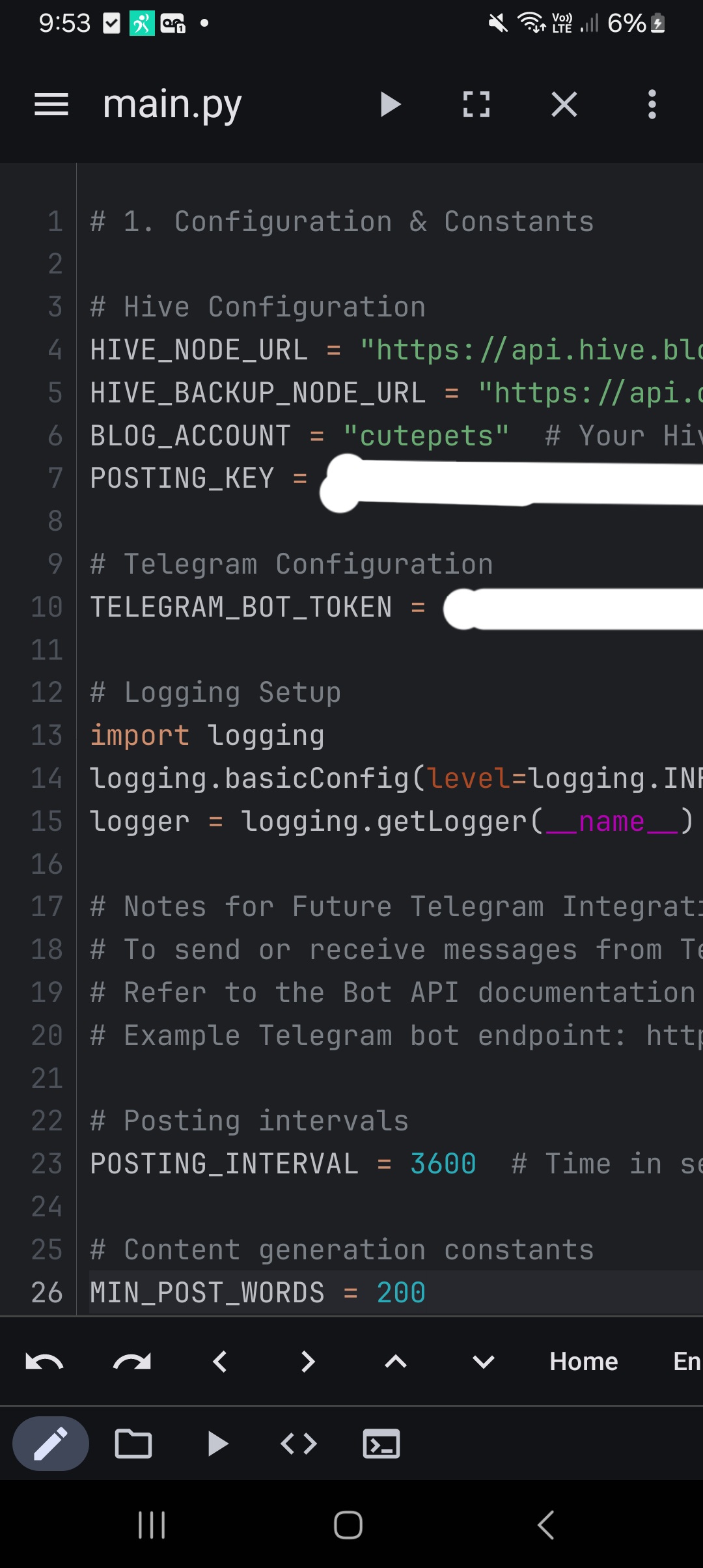
This is what mine looks like so far,but i have removed my password like shown in the photo,in this skeleton code we have have only cone up to number 4 in the instructions, when it is finished i will be posting the finished this so ceep and eye out.
1. Configuration & Constants
Hive Configuration
HIVE_NODE_URL = "https://api.hive.blog" # Main Hive node
HIVE_BACKUP_NODE_URL = "https://api.openhive.network" # Backup Hive node
BLOG_ACCOUNT = "cutepets" # Your Hive account
POSTING_KEY = (password)
Hive posting key
Telegram Configuration
TELEGRAM_BOT_TOKEN = (key/password)
Telegram bot token
Logging Setup
import logging
logging.basicConfig(level=logging.INFO, format='%(asctime)s - %(levelname)s - %(message)s')
logger = logging.getLogger(name)
Notes for Future Telegram Integration
To send or receive messages from Telegram, you'll use the Bot API.
Refer to the Bot API documentation for details: https://core.telegram.org/bots/api
Example Telegram bot endpoint: https://api.telegram.org/bot<TELEGRAM_BOT_TOKEN>/METHOD_NAME
Posting intervals
POSTING_INTERVAL = 3600 # Time in seconds between posts (1 hour)
Content generation constants
MIN_POST_WORDS = 200
MAX_POST_WORDS = 500
2. Imports
import asyncio
import time
import random
from hiveengine import HiveEngine # Assuming there's a library for Hive similar to BitShares
from hiveengine.account import Account
from hiveengine.post import Post
3. Logging Setup
import logging
logging.basicConfig(level=logging.INFO, format='%(asctime)s - %(levelname)s - %(message)s')
logger = logging.getLogger(name)
4. Global Variables and Configuration
last_post_time = 0
5. Initialization & Connection
def connect_to_hive():
try:
hive = HiveEngine(HIVE_NODE_URL)
hive.wallet.unlock(POSTING_KEY) # This might be different in Hive, check the exact method
logger.info(f"Connected to Hive node and wallet unlocked.")
return hive
except Exception as e:
logger.error(f"Failed to connect to Hive node: {e}")
raise RuntimeError("Unable to connect to Hive node.")
6. Content Management
def generate_content(topic=None):
# Here, you would integrate with an AI model for content generation
# Placeholder for content generation logic
if not topic:
topic = random.choice(["Technology", "Cryptocurrency", "Decentralization", "AI"])
# Example placeholder for AI interaction:
# content = ai_model.generate_text(topic, min_words=MIN_POST_WORDS, max_words=MAX_POST_WORDS)
# For now, using dummy text:
content = f"This is a blog post about {topic}. It should be interesting and informative."
return content
async def post_content(hive, account, content, title=None):
try:
if not title:
title = "Automated Blog Post"
post = Post(
author=BLOG_ACCOUNT,
title=title,
body=content,
tags=["hive", "blogging", "automation"]
)
await hive.post.submit(post)
logger.info(f"Posted: {title}")
except Exception as e:
logger.error(f"Failed to post content: {e}")
7. Main Blogging Loop
async def blogging_loop(hive, account):
global last_post_time
while True:
now = time.time()
if now - last_post_time >= POSTING_INTERVAL:
content = generate_content()
await post_content(hive, account, content)
last_post_time = now
await asyncio.sleep(60) # Check every minute
8. Main Execution Function
async def main():
try:
hive = connect_to_hive()
account = Account(BLOG_ACCOUNT, hive_instance=hive)
logger.info(f"Connected to Hive account: {BLOG_ACCOUNT}")
await blogging_loop(hive, account)
except Exception as e:
logger.error(f"Critical error in main execution: {e}")
raise e
Run the main function asynchronously
if name == "main":
try:
asyncio.run(main())
except Exception as e:
logger.error(f"Critical error in bot execution: {e}")
This is the set of instructions we have gone thrue so far.
1.Set Up Your Development Environment:
Python: Ensure Python is installed on your computer. You can download it from python.org.
IDE: Use a simple IDE like Visual Studio Code or PyCharm (Community Edition is free).
2.Install Necessary Libraries:
Open your command line or terminal.
Run these commands to install the libraries:
pip install hiveengine
pip install asyncio
3.Configure Your Hive Account:
HIVE_NODE_URL: Change this to a reliable Hive node API endpoint.
BLOG_ACCOUNT: Replace with your Hive account name.
POSTING_KEY: Use your Hive posting key. Keep this secure!
4.Understanding the Skeleton:
Functions:
connect_to_hive(): Connects to the Hive network.
generate_content(): Placeholder for content generation. You'll need to implement this with an AI model.
post_content(): Posts to Hive.blog using the Hive API.
blogging_loop(): Manages the timing and loop for posting.